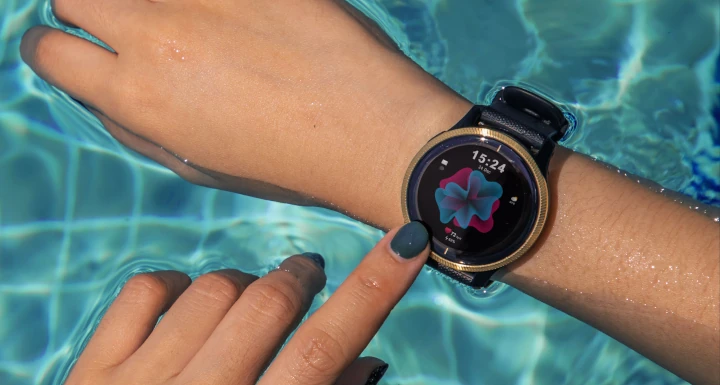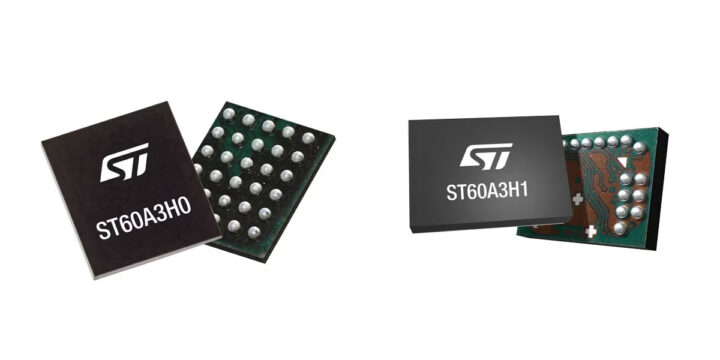STMicro ST60A3H0 and ST60A3H1 are short-range 60 GHz transceiver ICs that tunnel eUSB2, I2C, SPI, UART, and GPIO signals and aim to replace USB and other cables in consumer devices such as digital cameras, wearables, portable hard drives, and small gaming terminals. They should also find their way into industrial applications such as rotating machinery where cable use may be challenging.
The smaller ST60A3H0 chip provides more flexibility and requires an external antenna, while the ST60A3H1 chip is a fully integrated solution with a built-in linear antenna. Both are capable of USB 2.0 speeds of up to 480 Mbps and support UART, GPIO, and/or I2C signals so they are not limited to USB cables and can be used in a range of applications.
ST60A3H0 and ST60A3H1 key features and specifications:
- 60 GHz V-Band transceiver for short-range contactless connectivity up to 480 Mbit/s
- eUSB2, UART, GPIO, or I2C RF tunneling
- Low power consumption (typical values with a single 1.8 V supply):
- eUSB2 Rx/Tx – 110/130 mW
- UART/GPIO/I2C – 90 mW
- Standby – 23 μW
- Optimized BOM without external matching network and clock references. A reference clock may be used at one end of the RF link to comply with specific regional regulation
- ST60A3H0 features
- Integrated full RF transceiver operating in Half-Duplex mode
- 34 dB typical total link budget
- 50 Ω single-ended nominal RF input/output impedance with recommended PCB transition
- Single 1.8 V supply or dual supply 1.8 V (analog/RF) and 1.2 V (digital/GPIO)
- Package – VFBGA 2.2 x 2.6 x 0.8 mm, 30 balls, 5×6 array, 0.4 mm
- ST60A3H1
- Integrated full RF transceiver and linear polarization antenna, operating in Half-Duplex mode
- 42 dB typical total link budget, up to 5 cm free-space propagation loss
- Single 1.8 V supply
- Package – VFBGA 2.9 x 4.1 x 0.8 mm, 23 balls, 0.4 mm pitch
- Temperature Range – -20 to +85°C

Detailed technical data and evaluation kits are available but as explained in the press release getting access to those requires signing a non-disclosure agreement, so there’s limited public information. As I understand it there should be one transceiver in the device and another one connected to the host and data transfer can occur over a few centimeters distance. Charging does not seem to be handled by the solution.
The ST60A3H0 and ST60A3H1 60 GHz transceivers look to be especially useful for waterproof devices since they remove the need for cabling while keeping USB 2.0 compatibility, but should also enable thinner devices and support for rotating devices as illustrated in the video demo below with the earlier ST60A2 industrial-grade transceiver supporting SLVS or GPIO tunneling.
STMicro says the ST60A3H0 and ST60A3H1 are in mass production with a life-cycle of at least 10 years. Samples are available now at $5.00 and up. A few more details may be found on the respective product pages.

Jean-Luc started CNX Software in 2010 as a part-time endeavor, before quitting his job as a software engineering manager, and starting to write daily news, and reviews full time later in 2011.
Support CNX Software! Donate via cryptocurrencies, become a Patron on Patreon, or purchase goods on Amazon or Aliexpress






I don’t believe at all in the “aim to replace cables”. The first use of USB cables these days is to provide power. The level of power consumption for each chip is as high as some of the devices this intends to connect. Plus you plug a cable and stuff works. You don’t have to pair devices together. We could imagine “wireless cables” composed of a device connector to connect to a master, and a master with a USB-C power input, to connect to a device so that there’s no flying cable, but that still requires a cable on the… Read more »
Debugging cables is already unplesant enough, throw in a 60GHz link as well? No thanks.
5cm distance? All this only gets me 5cm? Might as well use a cable at that point and, like you say, get power as well.
Yeah. This took my back to the irda days of data transfer. Quite horrible altogether.
I like the multi-protocol tunneling, but that can be done with usb too using different endpoints AND you get power
I guess you could use this + QI to eliminate the need for a USB cable.. instead of just using a magnetic pogo-pin connector.. There is some development cost in those connectors, but I’ve you’ve done it once you can sell it for 10+ years
Pogos are still going to be cheaper than wireless.
Yup. Safer, cheaper, takes less physical space, more efficient charging and data transfer. The only positive is that it’s easier to reach higher IP ratings having a uni-body design
Guys, seriously? What about devices that need to rotate 360+degs while transmitting video, for instance? Do you really think this is possible using pogos? 😀 What about wear and tear on the connector? What about dirt? Maybe pogos or equivalent are cheaper, but surely not “safer” (I guess you mean from a data-integrity POV). And btw when you talk about “safety” you should define what you mean by “safe” since every industry and application has its own requirements and standards. Regarding power: rotary power connectors are much simpler, more reliable, and cheaper devices than the equivalent ones for high-speed data,… Read more »